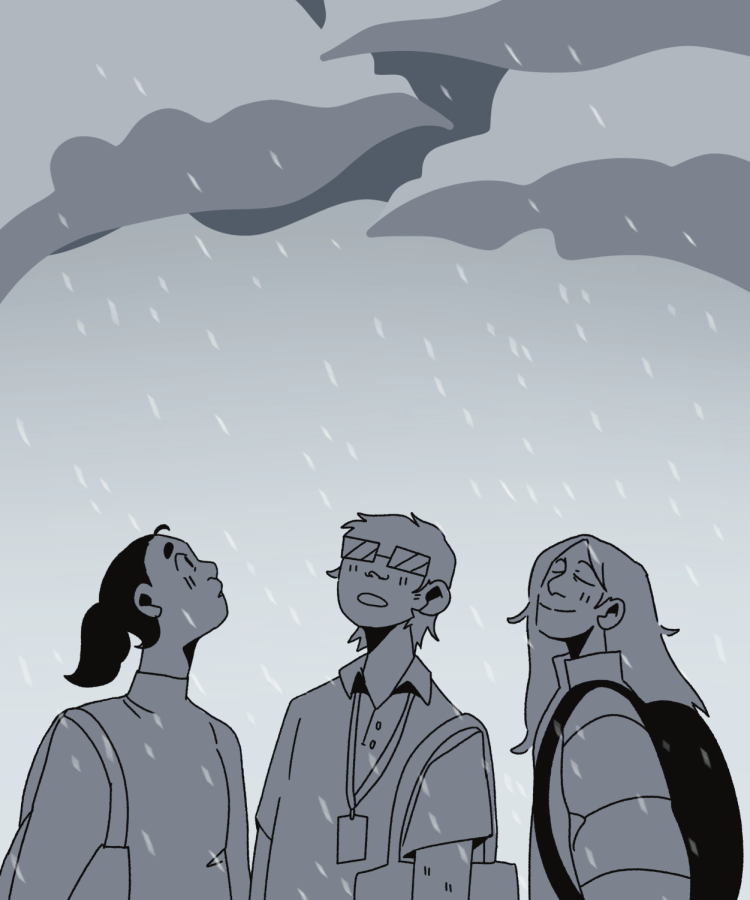Experts answer ’What is the smell before the rain?’
March 23, 2022
Dark clouds crowd the sky with their dim overcast shadows. Lightning cracks and a roll of thunder quickly follow. But before the rain starts to pour, a distinct smell lingers in the air.
A frequently asked question is what exactly the smell before it rains is, and why it occurs. Professionals in atmospheric sciences from the University were able to answer the question.
According to Stephen Nesbitt, a professor in atmospheric sciences, the scientific name for the smell that comes before rain is petrichor. Nesbitt explained how the scent is created.
“It’s actually a bunch of chemical interactions that happen as the rain falls through the sky and also when it hits the surface and hits things like plants,” Nesbitt said. “It’s all chemistry.”
Troy Zaremba, a graduate student studying atmospheric sciences, explained how plants interact with rain to create the smell.
Get The Daily Illini in your inbox!
“When it’s dry, plants will secrete oils and stuff that helps prevent other plants from sprouting up nearby,” Zaremba said.
Robert Rauber, a professor of atmospheric sciences and the director of the School of Earth, Society and Environment, said that the oils fall into the soil and interact with bacteria. He explained what happens to these oils when it rains.
“When it rains, these bacteria produce spores (airborne reproductive methods) that carry those oils mixed with other chemicals,” Rauber said. “There’s a particular chemical called geosmin that creates that fresh smell that you smell when it rains.”
Nesbitt said that the smell is produced as the first few droplets of rain start to hit the soil at the beginning of a rainstorm. These initial interactions are usually what is smelled.
“When the rain starts to hit plants, when the initial few drops start to fall, that’s when those chemicals are released,” Nesbitt said.
While petrichor is the smell that occurs before a rainstorm, Nesbitt and Rauber said that thunderstorms have a slightly different scent.
“I’m going to describe it as an electrical smell,” Rauber said. “But that’s actually ozone you’re smelling and ozone is produced by electrical charges.”
During a storm, lightning heats the air in the higher atmosphere and scatters the existing nitrogen and oxygen particles. Sometimes, three of the free-floating oxygen atoms combine and form ozone. The scent is noticeable after this process.
Wind serves as the carrier of these smells. Nesbitt said that after storms produce cold air through processes in the upper atmosphere, the air is released and takes the smell with it.
“You’ll feel that cold air start to rush towards you,” Nesbitt said. “That cold air rushes out of the front of the storm, but then also brings, for example, some of the ozone that might have been released by lightning up in the clouds.”
The air carries ozone, bacteria spores and plant oil in it and is the reason it is possible to smell a storm before it hits a certain area.
To both Rauber and Zaremba, the scent of rain reminds them of spring.
“I just find it very fresh,” Rauber said. “I think, if anything, it kind of brings this fresh ‘spring is here’ type of mood that you get.”
Nesbitt, however, has a different experience.
“It just kind of smells a little moldy, like when you’ve been down in your basement and you haven’t had a lot of ventilation,” Nesbitt said.
According to Nesbitt and Rauber, rain in the midwest is comparatively different than it is in other parts of the U.S. For example, the Midwest experiences a variety of storms and the full range of seasons.
Rauber said that the Midwest is also prone to having stratus clouds.
“Stratus clouds are big sheets of clouds that cover large areas and produce rain for long periods of time, but at a relatively low intensity,” Rauber said.
Similarly, Nesbitt said that rain droplets in the Midwest are smaller and more frequent in number and that in warmer areas, they are larger and fewer in number. He said that this is because of the difference in the type of aerosols — liquid and solid particles in the air.
“All raindrops form on a tiny dust, salt or pollen particle,” Nesbitt said. “The chemical properties of those aerosol particles can lead to different precipitation processes.”
Nesbitt explained how this applies to the Midwest.
“A lot of our rain is formed on tiny aerosol particles that come from the soil. If you go down to the tropics…their precipitation is formed on salt particles.”
Neither Rauber, Nesbitt or Zaremba think that climate change will impact the smell itself. But they do believe that it will affect the frequency that the scent occurs.
“I think those processes are going to happen in a warmer climate as much as they do now,” Nesbitt said. “We will probably have more precipitation and perhaps more severe storms going into the future here in the Midwest.”
Zaremba also said that there will be more storms in the future.
“I think like with climate change, you definitely have more extreme precipitation events because warm air can hold more water,” Zaremba said. “So basically, you end up getting more precipitation.”







